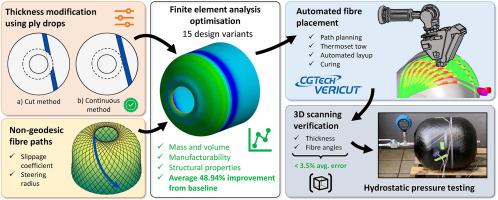Optimisation of a composite pressure vessel dome using non-geodesic tow paths and automated fibre placement manufacturing
IF 12.7
1区 材料科学
Q1 ENGINEERING, MULTIDISCIPLINARY
引用次数: 0
Abstract
Filament winding lacks the flexibility to produce composite pressure vessels with highly optimised thickness and fibre angles. Automated fibre placement can overcome this limitation using its selective material placement capability. In this work, two dome thickness optimisation strategies are introduced and evaluated for mass reduction and manufacturability. Additionally, fifteen non-geodesic fibre paths were examined using finite element analysis (FEA). The combined thickness and fibre angle optimised domes averaged a 48.94 % improvement in structural efficiency from the baseline. A demonstrator was manufactured, and thickness and fibre angle were measured with average differences of 3.45 % and 1.86 % from the simulations. Finally, hydrostatic pressure testing was performed to validate the FEA.

利用非测地线牵引路径和自动纤维铺放制造技术优化复合材料压力容器穹顶
在生产厚度和纤维角度高度优化的复合材料压力容器时,纤维缠绕缺乏灵活性。自动纤维铺放可以利用其选择性材料铺放能力克服这一局限性。在这项工作中,引入了两种圆顶厚度优化策略,并对其减小质量和可制造性进行了评估。此外,还使用有限元分析(FEA)检查了 15 条非大地纤维路径。经过厚度和纤维角度优化的组合穹顶的结构效率比基线平均提高了 48.94%。制造了一个演示器,测量了厚度和纤维角度,与模拟结果相比,平均差异为 3.45 % 和 1.86 %。最后,进行了静水压力测试以验证有限元分析。
本文章由计算机程序翻译,如有差异,请以英文原文为准。
求助全文
约1分钟内获得全文
求助全文
来源期刊

Composites Part B: Engineering
工程技术-材料科学:复合
CiteScore
24.40
自引率
11.50%
发文量
784
审稿时长
21 days
期刊介绍:
Composites Part B: Engineering is a journal that publishes impactful research of high quality on composite materials. This research is supported by fundamental mechanics and materials science and engineering approaches. The targeted research can cover a wide range of length scales, ranging from nano to micro and meso, and even to the full product and structure level. The journal specifically focuses on engineering applications that involve high performance composites. These applications can range from low volume and high cost to high volume and low cost composite development.
The main goal of the journal is to provide a platform for the prompt publication of original and high quality research. The emphasis is on design, development, modeling, validation, and manufacturing of engineering details and concepts. The journal welcomes both basic research papers and proposals for review articles. Authors are encouraged to address challenges across various application areas. These areas include, but are not limited to, aerospace, automotive, and other surface transportation. The journal also covers energy-related applications, with a focus on renewable energy. Other application areas include infrastructure, off-shore and maritime projects, health care technology, and recreational products.
 求助内容:
求助内容: 应助结果提醒方式:
应助结果提醒方式:


